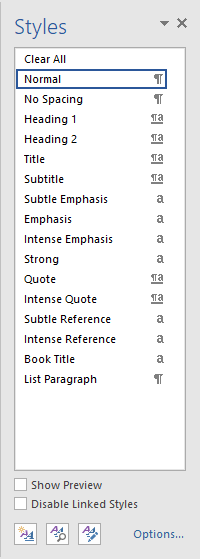

- #View style pane in word manual#
- #View style pane in word full#
- #View style pane in word plus#
- #View style pane in word series#
Remember that a paragraph is one or more lines-with or without text-that end in ¶, a symbol called a pilcrow. In any new Word document, every paragraph is, by default, Whether you know it or not, everything in your document is formatted as a style. Styles are simply sets of formatting instructions-and you can customize them however you’d like. Word styles-those little snippets of text formatting peering at you from the top of the page-can be especially mystifying.īut they don’t have to be. Microsoft Word is an amazingly robust set of tools, but few people ever use more than one or two of its powerful functions.įor many users, the icons that dot the ribbon at the top of each document are more intimidating than a complex math equation. So how do you do all of this in a fraction of the time direct formatting would require? This article will show you. Numbered items would always be ordered correctly. If you used Word styles, however, you could format every occurrence of each item with a single click-and effortlessly experiment with different options until you find the one you like. You’ll probably redo the whole document several times before you’re happy with the results.

If you’re like most users, you’ll format each item individually-a painstaking process known as direct formatting. Each file contains section titles, subheadings, footnotes, numbered lists, and,Īs you import text from the different contributors, your document begins to looks like a hodgepodge.
#View style pane in word series#
If the corresponding levels are marked with a style, they can be quickly and conveniently moved to the desired position using the outline view tools.You’re compiling a big document-maybe it’s a report for your annual department meeting or a series This view is also suitable for making corrections to the structure of a text and moving text sections around within the document swiftly and with ease. For a better overview, it’s possible to display only two levels, for example. The default outline view displays all levels of the document.
#View style pane in word plus#
In this view, the headings are arranged hierarchically – if there’s a plus sign on the left side of a heading, it means that it has another text level below it, while a minus sign is followed by continuous text only.
#View style pane in word full#
In the outline view it’s possible to move individual sections of a document clearly and with full control.


Navigation: The navigation function makes it possible to switch quickly between sections of the document.Adaptability: If only one style is used consistently within a document, then only this style needs to be adjusted when necessary to edit the whole document.Efficiency: Once the style has been created, it can be applied to any section of the document without having to be changed.Continuity: Format results in a consistent document layout.The following six reasons outline the advantages of using styles in Word:
#View style pane in word manual#
Initially, manual formatting may seem to be easier and quicker, but for longer texts it’s more efficient to use Word styles instead of repeatedly formatting sections of text separately. This is particularly noticeable when editing complex documents, such as final papers or manuscripts. Preset as well as custom styles make it easier to work on a text document.


 0 kommentar(er)
0 kommentar(er)
